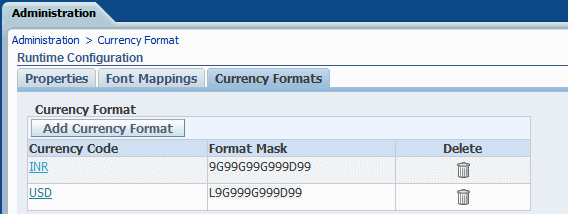Defining Currency Formats
Currency formats defined in the Administration Runtime Configuration page are applied at the system level. Currency formats can also be applied at the report level.
The report-level settings take precedence over the system-level settings here. For information on setting a report-level currency format, see Configuring Currency Formats in Report Designer's Guide for Oracle Business Intelligence Publisher.
Understanding Currency Formats
The Currency Formats tab enables you to map a number format mask to a specific currency so that your reports can display multiple currencies with their own corresponding formatting. Currency formatting is only supported for RTF and XSL-FO templates.
To apply these currency formats in the RTF template, use the format-currency function. See Formatting Currencies in Report Designer's Guide for Oracle Business Intelligence Publisher for detailed procedures.
To add a currency format:
The figure below shows sample currency formats.
